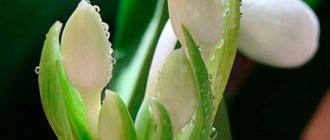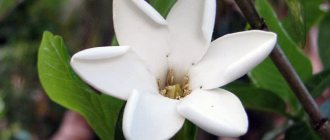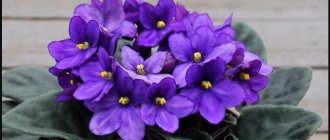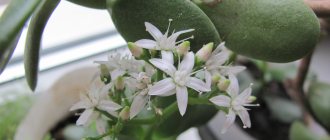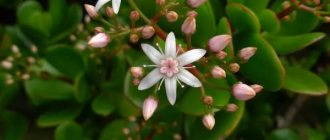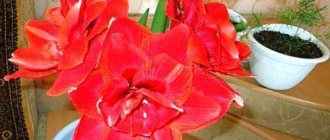Bud formation
Cyclamen begins to bloom after its dormant period ends (from the very beginning of June to September), and this happens gradually. From September to November, the plant “wakes up”: new green leaves begin to appear on it. And in December, when it has returned to the state it was in before hibernation, the plant finally begins to bloom: bright and variegated flowers grow on the peduncle, which do not fall off until the beginning of May.
Under all conditions created for the correct dormant period, cyclamen will bloom regularly.
The necessary conditions
First of all, active and regular flowering directly depends on how it spent the dormant period. When caring for cyclamen during the dormant period, you need to follow some simple conditions:
- The temperature should not exceed 20 degrees, and the most optimal would be 12 - 13 degrees. The plant itself should be in a dark place where it will not be exposed to direct sunlight.
- Watering is done once every 2 weeks, but you need to monitor the soil moisture and do not flood it. Otherwise, rotting of the bulb and subsequent death of the flower may occur.
- During this period, it is better not to feed the plant at all; at this stage, feeding will only harm the cyclamen.
After a period of dormancy and awakening of cyclamen, it is necessary to provide the conditions necessary for its flowering:
- There should be no damage to the flower in the form of cracks, otherwise it will begin to rot and die instead of blooming.
- After hibernation, the plant is transplanted into new nutrient soil, and when placing the bulb in the ground, it is necessary that 1/3 of it is above the ground. This is necessary for flowering to begin at all.
- It is best to place cyclamen on a south or west window, because there is no bright direct sunlight, which causes great harm to the leaves of the plant. If it is not possible to keep it on the windowsill, you can place it in any place where there is no direct sunlight.
- Maintaining a comfortable temperature for cyclamen: during the flowering period it should not rise above 15-18 degrees. At this time, he prefers coolness, as at rest.
- It is recommended to increase watering to once a week, and it is important to monitor whether the top layer of the substrate dries out and whether water stagnates at the bottom of the pot where the bulb is located.
You can make holes in the bottom of the pot and put a tray down where excess water will drain. Important! When watering, do not allow moisture to get on the leaves. - Before the cyclamen begins to bloom, i.e. during its awakening, you need to spray its leaves, and best of all, the air around it. Such spraying can be carried out once a week.
- Feeding occurs once every 2 weeks with complex fertilizers that are suitable for absolutely any plant.
This type of care for cyclamen should be done until its leaves begin to turn yellow and fall off along with the flowers, i.e. until the very beginning of the dormant period.
Growing difficulties
One of the main problems of cyclamen is the shortening of the flowering period. Most often, the reason for the rapid fall of flowers and the lack of new buds is improper watering, too high a room temperature and dry air. Carefully monitor watering and feed the plants on time. Ready-made industrial fertilizers intended for this species are suitable - dilute the liquid or powder according to the recommendations on the package.
Dry air and direct sunlight can cause leaves to yellow and fall off. Shade the cyclamen - light blinds are suitable for this. Please note that the sun not only shines, but also heats, and cyclamen does not tolerate temperatures above 17°C.
Cyclamen is quite resistant to pests. Most often it is affected by the cyclamen mite, which resembles dust on the underside of the leaf. Affected leaves curl and fall off. It is useless to treat the plant with pesticides. Tear off the affected leaves and stop intensive spraying for a while.
The exotic flower cyclamen is also called alpine violet by many. Having seen this plant, few people will remain indifferent to its beauty. However, there are even fewer people who dare to have a flower at home. It is believed that keeping cyclamen at home is quite difficult. But for many gardeners, the plant develops well, blooms and feels good.
Description
Cyclamen is a perennial tuberous or bulbous plant. Its lifespan is about twenty years. Various species have white, burgundy, purple and pinkish flowers. Cyclamen is native to the Mediterranean and the Middle East. The most widespread are European and Persian varieties.
How to care for cyclamen
Contrary to popular belief, cyclamen is not a very capricious plant. There are special requirements for growing a flower, and caring for cyclamen at home does not consist only of timely and proper watering. When choosing a plant in a flower shop, you need to look at its leaves and tubers. The green parts of the crop should not sag, and the tubers should be selected without buds. Plants are usually sold planted in a peat substrate. Such soil is completely unsuitable for normal development. The plant must be replanted in ordinary soil. During replanting, it is necessary to completely remove all rotten roots and peat clods, and place drainage at the bottom of the flowerpot.
Watering
You should not pay attention to strict recommendations and instructions. Each plant requires an individual watering plan, which depends on the growing conditions.
When moisturizing and caring for cyclamen at home, you need to adhere to the basic rule: do not flood the pot or overdry the plant. Although the last condition is not so terrible for culture. The sad thing is that once you overwater a plant, you can provoke its death as a result of rotting roots.
Lighting and temperature conditions
The flower loves light, but is afraid of direct sunlight. It is better to place the pot on the north side of the window. Otherwise, shading will be required. Caring for cyclamen at home requires knowing that it should be placed in a cool place. The plant reacts poorly to heat above 14 degrees. Therefore, in winter it is necessary to place the pot closer to the window, and in summer, on the contrary, further away.
Transplantation and propagation, special requirements
Cyclamen should be replanted every year in fresh soil; it is recommended to do this in the summer. The Persian variety can only be propagated by seeds, the European variety by dividing the bulb. After flowering is completed, the plant goes into a dormant state, its leaves turn yellow, and the tubers remain bare by the beginning of summer. At this time, special care for cyclamen at home is necessary. Watering should be reduced (it is recommended to add water to the pan), and after dropping the leaves, the flower is placed in a cool place (cellar, pantry). At the end of summer, cyclamen is transplanted into new soil and returned to its original place. After the first leaves appear, watering is resumed as before.
Causes
The most important and common reason why cyclamen refuses to bloom:
failure to comply with the conditions listed above, perhaps watering was rare but plentiful;- it was not fed and so on.
If he has done everything that was required of the grower, and the plant still does not begin to bloom, you need to take into account whether the cyclamen was purchased in a specialized store or propagated at home.
In the first case, everything is somewhat more complicated: in order for cyclamens to always have a marketable appearance, they are fertilized with chemicals that force them to bloom constantly (or most of the year). As a result of such feeding, the plant’s life cycle is disrupted, and you just need to wait until it returns to normal. It is for the same reason that cyclamen may not hibernate.
On a note. If the plant is young, it may also not bloom, because it also has not yet set up its cycle, according to which it will live in all subsequent years.
In most cases, cyclamens begin to bloom only after 2-3 years of their “life ,” so there is no need to expect that a plant that has just been transplanted into its first individual pot will begin to actively bloom.
It is possible that the cyclamen rhizome rots as a result of improper watering or damage to the bulb during transplantation. In this case, you need to replant the flower again, while ridding it of the damaged parts. Or it has been attacked by pests, which need to be gotten rid of immediately.
What insects like to eat cyclamen?
Another problem when growing cyclamen is pests.
The juicy leaves of cyclamen attract the attention of not only gardeners, but also various insects. Having established who exactly attacked your flower, you can help it get rid of the “uninvited guests”
This can be done using a magnifying glass or by the nature of the changes occurring in the bush.
The appearance of a cyclamen mite is easy to notice by the following signs:
- first, the leaf plates begin to lose their shape and bend ugly;
- then they stop growing and become hard;
- the inflorescences fade, and the flower stalks become deformed (curved).
On this topic:
BACK
FORWARD
1 of 68
If thrips appears on the cyclamen, the leaves of the plant:
- first covered with white dots;
- then they merge into gray-silver spots;
- begin to curl;
- gradually die off.
To combat thrips, use Aktara or Fitoverm. At the initial stage, when there are not very many pests, drugs can help get rid of them. In case of massive damage, the flower dies.
One of the most dangerous pests of cyclamen is the scale insect, primarily for the reason that it is generally impossible to get rid of it with the help of drugs. Often gardeners do not even notice it until the flower begins to disappear. If you see convex growths on the petioles, peduncles or the back of the leaves, this is not a deformation of the plant, but a very dangerous enemy. The scale insect is covered on top with a strong semicircular shell that protects it. The insect is firmly attached to the flower, literally merging with it into one whole, and no chemicals will help here. The only way to get rid of scale insects on cyclamen is mechanically, by manually tearing them off.
A common “guest” on cyclamen is aphids. These small white insects suck the juices out of the leaves, as a result of which they begin to curl and deform, becoming covered with a sticky coating, and young leaves appear small and also curved.
Top dressing
Fertilizing, as mentioned above, is done once every 2 weeks with standard fertilizers suitable for any other plant.
To prevent cyclamen from being exposed to various diseases and pests, gardeners recommend steaming the soil for replanting and treating it with a solution of potassium permanganate. You can buy the substrate or prepare it yourself. You can buy regular or special soil for cyclamen.
If you wish, you can do it yourself: add 1 part perlite or sand to 2 parts of purchased soil.
You can also add leaf soil:
- 1 part of ready soil;
- 1 part of land;
- 1 part perlite or sand.
It is highly not recommended to add peat to the substrate for cyclamen.
Pruning and replanting
As soon as the cyclamen leaves begin to turn yellow, they are disposed of, i.e. trimmed.
Important! Some gardeners, wanting to send the plant into hibernation, cut off the still green leaves and twist out its flowers. This is absolutely forbidden to do!
The transplant is carried out immediately after the cyclamen's dormant period ends , into pre-prepared soil (options for preparing the substrate are indicated above).
- First you need to choose a pot of the appropriate size: in a pot that is too small, the plant will not bloom, and in a large one, the bulb may begin to rot, so the optimal size is the same height as the previous one, but the diameter should be slightly larger.
- After, having separated the rotten parts from the rhizome, if any, and checking it for cracks or tears, you can transfer the rhizome to a new pot, after placing the soil so that 1/3 of the bulb looks out of the ground.
- If desired, you can add ash or dolomite to the soil as a fertilizer for more active growth.
Flower propagation methods
Growing cyclamen at home, sooner or later the owner thinks about propagation, which in the future can be presented to friends and family for a celebration. Knowing how cyclamen reproduces will help you achieve success faster.
Reproduction by tuber division
This is a widespread method that is preferred by most gardeners due to its simplicity and effectiveness.
However, it is important to consider that the tuber is a vulnerable part. Here it is important to follow some recommendations on how to propagate cyclamen correctly
Important! The method is recommended to be used only for large specimens with overgrown tubers. The procedure takes a total of 2-3 days:
The procedure takes a total of 2-3 days:
- First, the soil is moistened. This is necessary to make it easier to remove the root system from the pot.
- After a day, you can start dividing. To do this, wash off the soil from the roots using settled water at room temperature.
- Using a sharp knife, carefully cut the tuber into 2 parts. The maximum permissible number of divisions from one bulb does not exceed 4 pieces. The location of the cut should be in such a way that each part has at least one growth point and a heel from which the roots will grow.
- Leave the cutting for 3-4 hours to dry, after which the cut areas are treated with charcoal powder and left for another 18 hours to dry.
As the division of the bush is completed, you can begin planting in the ground.
Important! With this option, the bushes can often die. Also, if during a planned transplant, new small shoots formed on the mother tuber were noticed, then they can be used as planting material
To do this, the baby is carefully separated from the main bush, the cut areas are treated with crushed activated carbon and planted in a cup with regular soil. Cover the top with film or another glass, creating a greenhouse effect. As the leaves sprout, the film is removed and the flower is cared for as if it were an adult.
Also, if during a planned transplant, new small shoots that have formed on the mother tuber were noticed, then they can be used as planting material. To do this, the baby is carefully separated from the main bush, the cut areas are treated with crushed activated carbon and planted in a cup with regular soil. Cover the top with film or another glass, creating a greenhouse effect. As the leaves sprout, the film is removed and the flower is cared for as if it were an adult.
Note! Whatever option is chosen, the separation procedure is carried out during the rest period
How to force buds to appear at home?
How to make it bloom at home? What needs to be done for regular cyclamen flowering? Comply with all the requirements for this: temperature, humidity, proper watering, fertilizing. These are fairly simple and standard steps for growing almost any plant, so there is nothing complicated about getting your cyclamen to start blooming.
If the plant still does not bloom, then perhaps it was attacked by some pests that you have not yet noticed.

